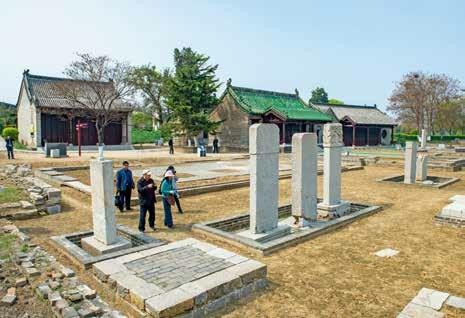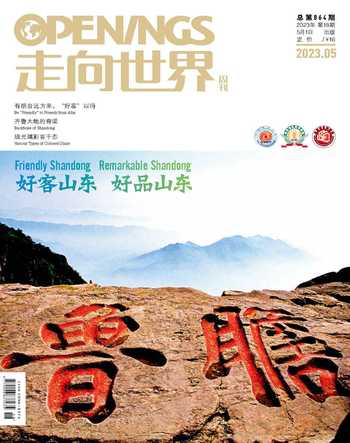運河岸,拾“遺”懷古
郭曉娟
京杭大運河在山東蜿蜒643公里,為沿線地區留下極為豐富的歷史文化遺產。作為中國古代水利工程的一大杰作,戴村壩集“江北都江堰”“天下第一壩”“運河之心”等多項美譽于一身。
站在觀景臺上凝神遠眺,戴村壩似巨蟒若長龍,橫臥于汶水河道,氣勢磅礴。“每到豐水季節,萬馬奔騰的大汶河水會跨越戴村壩,飛流直下,形成一道巨大的瀑布,蔚為壯觀。”戴村壩博物館講解員馬海燕介紹,戴村壩汛期分流泄水,氣勢磅礴,轟鳴聲震數里,宛若“虎嘯龍騰”。由于季節原因,雖沒能一睹“戴壩虎嘯”的運河壯景,但其“闊而大”的氣勢仍讓記者嘆為觀止。
戴村壩凝聚著古人智慧的高卓建筑技藝,得到古今中外人士的贊譽。清康熙皇帝在《敕封永濟神開河治泉實跡》中對其這樣描述:“此等膽識,后人斷斷不敢,實亦不能得水準如斯之準,真是創無前而建非常也。”19世紀初,荷蘭水利專家方維觀看戴村壩后由衷贊嘆道:“此種工程,當十四、十五世紀工程學胚胎時代,必視為絕大事業。” 2010年,著名水利專家譚徐明在看過戴村壩的設計、構造和作用后,與其他大運河申遺考察組專家一致認為,戴村壩修筑難度大、技術含量高、功能發揮絕,既有精髓傳承,又有獨特創造,達到了中國古代治水巔峰,堪稱“中國古代第一壩”。
古時,大運河在少水季節,常因水量不足斷流、淤塞而停止漕運。明永樂年間,明成祖朱棣下令疏浚運河,工部尚書宋禮采納了民間水利專家白英“引汶濟運”的建議,分流汶水到南旺的最高處,從南旺分水南北,即所謂“七分朝天子,三分下江南”之說。戴村壩建成后,大運河制高點水量不足的問題得以破解,使船只暢通無阻,“八百斛之舟迅流無滯”,保障了明清兩代500多年的漕運暢通,對中國南北經濟交流、文化融合、社會發展起到了重要作用。
馬海燕介紹,戴村壩分亂石壩、滾水壩、玲瓏壩三段,玲瓏壩比滾水壩高10厘米,亂石壩比滾水壩高30厘米;主石壩底為柏木,用黏土灌注,表層用一噸至六噸以上的條石鑲嵌,以鐵鋦、鐵扣相連,堅若磐石。隨著大汶河水位的升降,三壩分級漫水,既保證了小汶河持續供水,又能排洪防溢。
歷經滄桑歲月,任憑風吹浪打,戴村壩仍固若金湯,巍然屹立。如今,大汶河水經過戴村壩已不再流入運河,而是注入東平湖,但戴村壩在緩洪攔沙、控制河勢、灌溉農田等方面仍發揮著重要的作用。
作為大運河上重要的文化印記,戴村壩被認定為“世界文化遺產”“國家重點文物保護單位”“國家水情教育基地”“國家水利風景區”。臨壩而建的戴村壩博物館,依托水工文化遺跡遺物,通過遺物展廳、模型展廳、圖片展廳、引水展覽廳、3D影院等,向游客集中展示戴村壩的歷史、價值、功能以及京杭大運河的燦爛文化。
可以說,大運河是一條文明走廊,亦是一條鮮活的遺產、一段流淌的歷史。大運河山東段各市級規劃中共列入遺產點 152 處,四女寺樞紐、哨馬營樞紐、臨清閘、會通閘等水工設施,臨清運河鈔關、魏灣鈔關、阿城鹽運司、濟寧河道總督署遺址等運河附屬遺存,如珍珠般綴在大運河沿岸,連接著運河的命脈,成為大運河最亮麗的風景線。

隨著中國大運河國家文化公園建設提速,大運河山東段文化遺產在保護和傳承中迎來新生。京杭大運河遺產中具有代表性的水利工程南旺樞紐工程遺址,與汶上文廟、楊店鎮家風家訓館等串聯,形成大運河南旺樞紐研學旅行線路,并成為獨具特色的“文化+考古”研學品牌;位于德州市境內的四女寺水利樞紐,隨著開閘泄水,標志著一個世紀以來京杭大運河首次全線通水;曾居中國“八大鈔關”之首的臨清運河鈔關,將變身展示鈔關文化的片區……
循著時光的步伐,行走于大運河沿岸拾“遺”,既可細細品味塵封千年的歷史,亦可感受古老運河在新時代煥發出的生機活力。
編輯/魏偉
Cherish Heritage and Recall the Past by the Canal
The Shandong Section of the Grand Canal, with a total length of 643 kilometers, has left a rich historical and cultural heritage for the areas along the section. As a masterpiece of ancient Chinese water conservancy engineering, the Daicun Dam enjoys such fine reputations as “Dujiangyan to the North of the Yangtze River”,“Worlds First Dam”, and “Heart of the Canal”.

The dam comprises three sections, i.e. the Luanshi Dam, the Gunshui Dam and the Linglong Dam. With the rise and fall of the water level of the Dawen River, the three dams release water at different levels, thereby not only ensuring the steady supply of water from the Xiaowen River, but also discharging floodwater and pre- venting inundation.
After going through vicissitudes, regardless of winds and waves, the Daicun Dam remains impregnable, and stands lofty and firm. Now, the water of the Dawen River no longer flows into the canal, but runs into the Dongping Lake via the Daicun Dam. However, the dam still plays a significant role in mitigating floods, retaining sediments, controlling the river regime, and irrigating farmland.
As an important cultural hallmark on the Grand Canal, the Daicun Dam has been recognized as a“World Heritage Site”, a “Key National Heritage Conservation Unit”, a “National Water Regimen Education Base”, and a “National Water Conservancy Scenic Area”. Relying on water conservancy culture rel- ics, the Daicun Dam Museum built near the dam gives an intensive introduction to the dams history, value, function and role, as well as the splendid culture of the Grand Canal to visitors by means of a relic exhibition hall, a photo exhibition hall, a diversion exhibition hall, a 3D cinema, and so forth.
The Shandong Section of the Grand Canal has a total of 152 heritage sites listed in municipal planning. Dotted on the banks of the canal like pearls, they are connected to its lifeblood, and become the most gorgeous sight there.
With the accelerated construc
tion of the Grand Canal National Culture Park, the cultural heritage of the Shandong Section has been renewed in the process of protection and inheritance.


